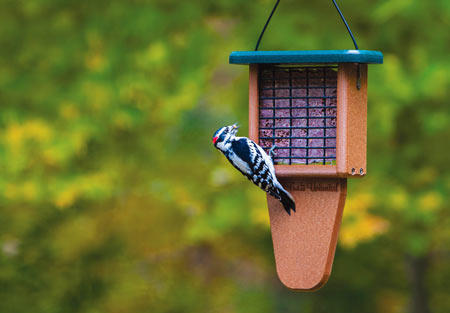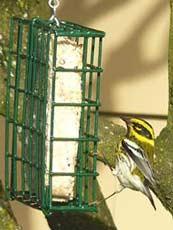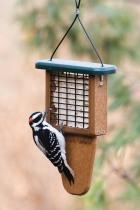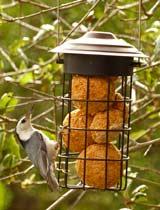Attracting Birds with Suet

What is suet and why should I use it?
Suet is fat. In the birdfeeding context, suet generally comes in square cakes combining rendered beef fat with grains (to reduce melting and gooeyness) and nuts (because birds like them). There are a few compelling reasons to offer suet.
- You can attract more kinds of birds than with a seed feeder alone, including woodpeckers, winter warblers, kinglets, bushtits, and more.
- Suet is really easy to squirrel- and rodent-proof by offering suet cakes containing hot pepper: taste-sensitive mammals find them too spicy, but birds like them just fine.
- Everything else about it is easy too. Suet cakes are compact, long-lasting and inexpensive, and don't leave any shell waste or mess behind.
Who does it attract?
Similarly to peanuts, suet is a low-mess food which appeals to insect-eating, nut-eating, and omnivorous birds like woodpeckers, jays, titmice, chickadees, and nuthatches more than the mostly seed-eating house finches and goldfinches. This means that suet doesn't strongly attract the big flocks of finches you see at your seed feeder (so each cake lasts longer), but instead draws a steady train of less numerous, but more varied bird species. During winter cold spells when insects are scarce and birds need to replenish calories lost just keeping warm, suet can also draw less common insect-eaters such as flickers, Townsend's warblers, yellow-rumped warblers, kinglets, and bushtits. But woodpeckers are perhaps the most reliable and sought-after suet specialist:
How do I provide suet to birds?
There are several kinds of feeders available, which I invite you to check out in our online store. The most common form of suet is in square cakes of a standard size, although you can also use our spreadable Bark Butter, our larger cylinders, small nuggets, or our larger suet balls. For square suet cakes, the most basic feeder is a simple and inexpensive hanging cage. For a few dollars more, you can get more decorative models or feeders with a tail prop, which helps the larger woodpeckers feed more easily, rather than flopping around on the smaller cages. Upside-down feeders let you cater specifically to clinging birds like woodpeckers and chickadees, while slowing down poor clingers like jays or crows. Caged feeders keep out larger birds and squirrels.
|
Basic suet cage with Townsend's Warbler |
Recycled plastic suet feeder with woodpecker tail brace |
Balls of suet are the preferred shape in England, birthplace of birdfeeding |
Any downsides or difficulties?
Not many, and none that aren't easily dealt with. Suet is a naturally very low-mess food, with no shells and a stuck-together consistency that doesn't drop food to the ground. During hot weather, some suet cakes left in direct sunlight may get soft and gooey, but No-Melt Suet Dough Cakes are available that include a higher ratio of grains-to-fat, adding more corn or oats to give a more solid consistency.
Suet is also the easiest food to squirrel-proof. While specialty caged feeders can protect any flavor of suet cake, you can also simply use Hot Pepper Suet Cakes, which birds like just fine, but which deter squirrels and rodents from feeding. (Mammals have a much more sensitive sense of taste – while the pepper will not harm squirrels, it's just too spicy for them.)
 Feeding seeds to birds seems pretty normal and natural. But how did we start making these special fat cakes for birds?
Feeding seeds to birds seems pretty normal and natural. But how did we start making these special fat cakes for birds?
Suet is actually the most traditional of birdfoods. Long before sunflower became the default, commercially available "bird seed," fat was what people put out for birds, from 19th century English country gentlemen-ornithologists to Americans like John Muir's contemporary, friend, and fellow man with a long white beard John Burroughs (pictured here). These guys had to make do with hanging a bone from a rope or nailing some bacon to a tree. But if they had access to suet cakes full of mealworms and peanuts, they'd probably use them happily.
Suet: John Muir would probably use it!




